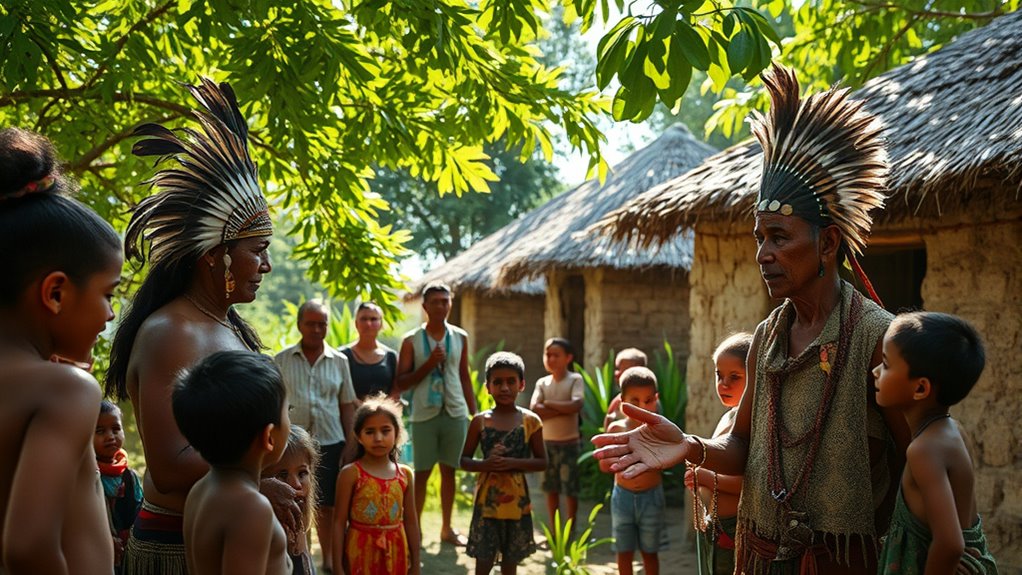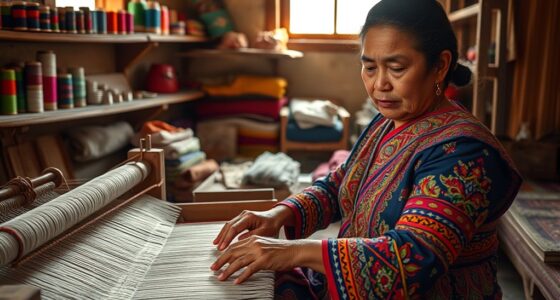To respectfully visit Indigenous communities, always seek permission before entering land or sacred sites and follow tribal protocols. Support Indigenous-led tours and purchase authentic crafts to promote their economy. Respect cultural customs, dress appropriately, and avoid touching artifacts. Be mindful of community privacy and avoid photography without consent. By practicing responsible tourism and honoring cultural traditions, you help conserve their heritage. Continue exploring how to guarantee your visit is meaningful and respectful.
Key Takeaways
- Verify Indigenous ownership and leadership of tours, ensuring cultural respect and community protocols are followed.
- Obtain necessary permits and permissions before visiting or participating in activities on tribal lands.
- Support authentic Indigenous-led experiences that promote cultural preservation and benefit local communities.
- Respect community-specific customs, privacy, and sacred sites, avoiding photography or actions that may cause disruption.
- Engage with Indigenous stories and resources responsibly, honoring protocols and promoting cultural understanding.
Understanding Tribal Lands and Permission Protocols

Understanding tribal lands requires respecting their legal, cultural, and spiritual significance. When it comes to land management, many activities like hunting, fishing, or exploration need permits before you engage. These permit procedures guarantee that tribes maintain control over their resources and preserve their traditions. You should always check with tribal authorities or visit their websites to find out what permits are necessary for your planned activities. Respecting these protocols is vital for a smooth visit and to avoid misunderstandings. Federal laws, such as the NHPA, also require consultation with tribes for projects affecting their lands. By following permit procedures and being aware of land management rules, you honor the sovereignty and cultural heritage of Indigenous communities while enjoying your visit responsibly. Researching permit requirements beforehand helps ensure compliance and demonstrates respect for tribal sovereignty. Additionally, understanding tribal sovereignty is essential to appreciate the tribe’s authority over their lands and resources.
Respecting Sacred and Spiritual Sites

When visiting tribal lands, respecting sacred and spiritual sites is essential to honoring Indigenous traditions and beliefs. Sacred site preservation depends on your understanding and adherence to local protocols, ensuring these spaces remain intact and revered. Recognize that these sites are active spaces of spiritual significance, and your actions can impact their integrity. Always seek permission from tribal authorities before visiting and follow their guidance on behavior, dress, and photography restrictions. Avoid touching artifacts or altering the landscape, which can damage the site’s spiritual essence. Maintaining silence and showing respect during your visit helps uphold the site’s sanctity. Remember, respecting spiritual access rights isn’t just courteous; it’s crucial for preserving these sacred places for future generations. Additionally, colonial legacy continues to impact Indigenous rights and cultural sites, making it even more important to approach these locations with sensitivity and respect. Practicing cultural humility demonstrates your acknowledgment of Indigenous sovereignty and helps foster respectful relationships.
Adhering to Cultural Etiquette and Behavior Norms
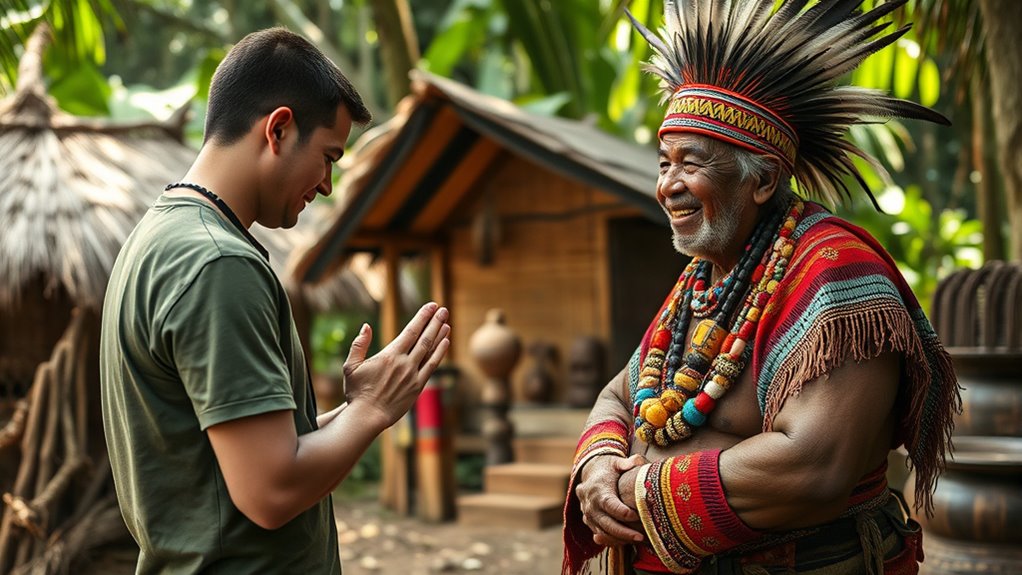
When visiting tribal lands, it’s crucial to respect privacy boundaries and follow local dress codes and conduct norms. Always ask permission before photographing or recording people and events, and dress modestly to show respect. Respect for tribal customs and ceremonies extends to understanding and adhering to community-specific expectations, which may include particular dress codes or behavioral guidelines. Additionally, being aware of cultural etiquette helps foster positive interactions and demonstrates your genuine regard for the community’s culture. By observing these practices, you help build trust and demonstrate your genuine regard for the community’s culture.
Respect Privacy Boundaries
Respecting privacy boundaries is essential when engaging with Indigenous communities during tribal tours. Community privacy centers on collective rights related to land and culture, not just individual space. To honor these norms, you must respect land boundaries and avoid intrusion into daily life or livelihood areas without permission. Always seek explicit consent before entering or photographing sensitive locations. Minimize your footprint to prevent disrupting community routines or exposing sacred sites. Respect for privacy also involves understanding and supporting Indigenous data sovereignty, ensuring their control over personal and cultural information. Utilizing appropriate wall organization systems can help reduce visual clutter and maintain respectful boundaries during visits. By following these principles, you help preserve community autonomy and foster respectful, meaningful interactions. Remember:
- Respect land boundaries and territory
- Seek permission for access or photos
- Avoid intruding on livelihoods
- Support data sovereignty efforts
- Minimize your impact
Follow Dress and Conduct
How you dress and behave during a tribal tour communicates your respect for the community’s values and traditions. Wearing traditional attire or ceremony dress shows you honor their customs, but only if permitted by community members. Avoid clothing with offensive graphics or slogans, as these can insult tribal spirituality. Modest, neat dress—using subdued colors and simple styles—demonstrates humility, especially during solemn events. Be mindful of your conduct: speak calmly, listen attentively, and avoid disruptive behavior around elders or during ceremonies. Ask permission before recording or photographing anything sacred, and never touch or remove cultural artifacts or offerings. Follow all posted signs and instructions from tribal guides, recognizing that respectful dress and conduct are essential to honoring the community’s sacred spaces and traditions. Understanding tribal customs and protocols helps ensure your visit is respectful and meaningful. Additionally, being aware of cultural sensitivities can prevent unintentional offenses and foster genuine connections.
Supporting Indigenous Economies Through Responsible Purchases
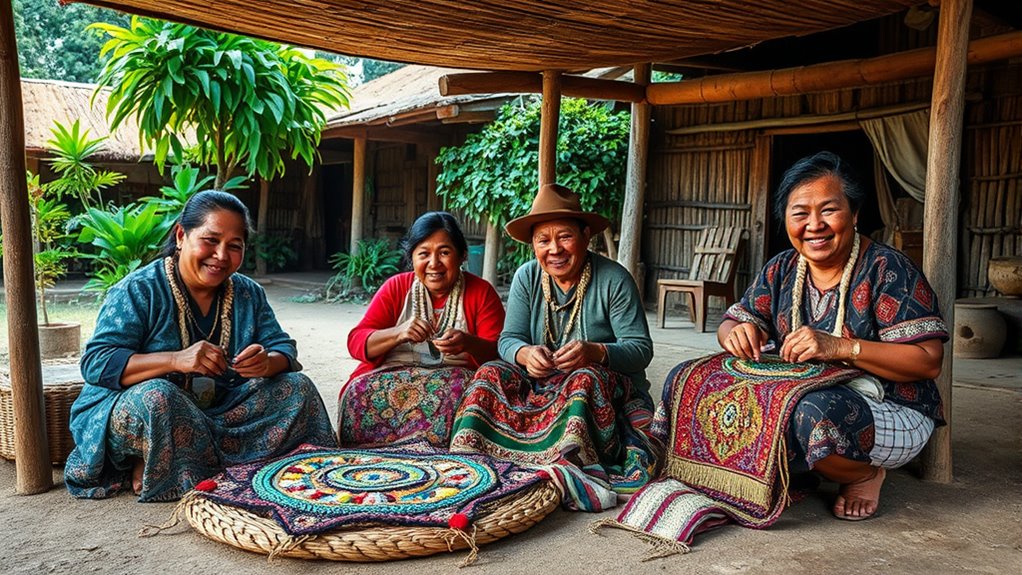
Supporting Indigenous economies through responsible purchases helps sustain traditions, create jobs, and give communities greater control over their economic futures. Making mindful choices helps ensure that the benefits of tourism are shared equitably and contribute to long-term community well-being. Additionally, understanding the importance of personality traits can enhance respectful engagement and foster genuine connections with Indigenous communities.
Purchase Authentic Artworks
Buying authentic Indigenous artworks is a powerful way to support Indigenous economies and preserve cultural heritage. When you purchase from verified sources, you help guarantee that digital copyright protections are respected, preventing inauthentic products from circulating. Supporting genuine artists sustains cultural preservation and promotes economic growth within Indigenous communities. To make responsible purchases, consider:
- Buying directly from recognized art centres or verified artists
- Checking for authenticity certificates or provenance
- Supporting platforms committed to cultural preservation
- Avoiding products that resemble Indigenous art but lack proper attribution
- Ensuring sales revenue goes directly to artists, enhancing their income
Your responsible purchase not only boosts individual artists but also strengthens community programs and safeguards cultural knowledge, fostering a sustainable and ethical Indigenous art market. Research shows that engaging with reputable sources significantly reduces the risk of purchasing forgeries or misrepresented works.
Choose Indigenous-Owned Tours
Supporting Indigenous-owned tours is a powerful way to boost Indigenous economies and guarantee cultural integrity. Historically, many Indigenous communities faced marginalization and economic challenges, but tourism offers a pathway for sustainable development. By choosing Indigenous-led experiences, you help preserve cultural traditions and assure that tourism benefits remain within the community. This responsible purchasing fosters environmental conservation, as many Indigenous operators prioritize eco-friendly practices rooted in traditional knowledge. Supporting these small businesses—most without paid employees—creates jobs and sustains local languages and customs. Globally, Indigenous tourism is growing, driven by demand for authentic cultural engagement. Your choice directly empowers communities, promotes cultural preservation, and encourages sustainable, community-controlled tourism that respects both the environment and Indigenous heritage. Incorporating cultural authenticity into your travel choices ensures a respectful and meaningful experience for all involved.
Choosing Ethical and Indigenous-Owned Tour Operators
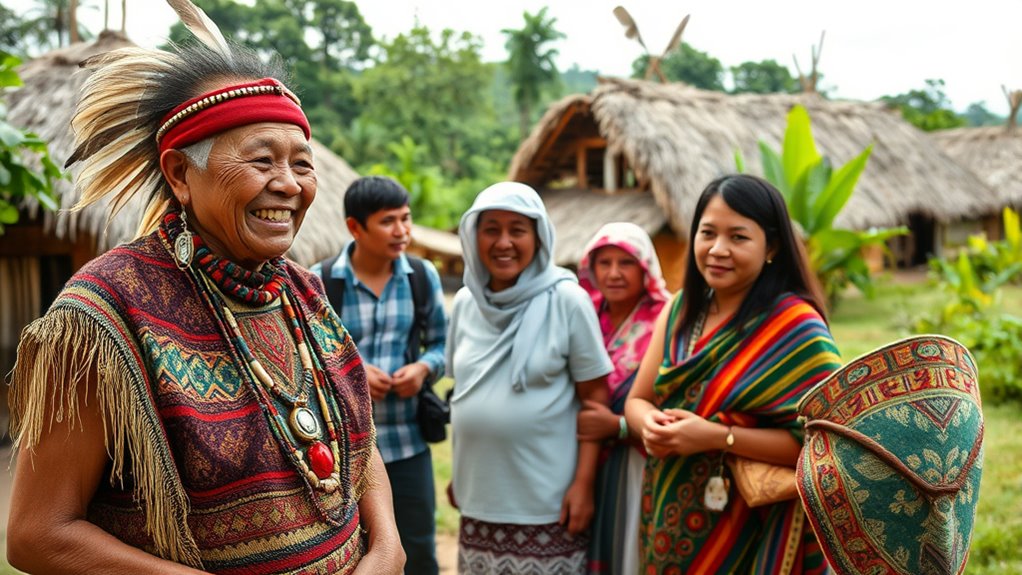
Choosing ethical and Indigenous-owned tour operators guarantees that your travel experiences respect and preserve Indigenous cultures while directly benefiting their communities. By selecting these operators, you support cultural preservation and uphold Indigenous governance, ensuring authentic representation. To make informed choices, consider:
- Verifying Indigenous ownership and leadership
- Evaluating commitment to cultural respect and community protocols
- Prioritizing collaboration with local Indigenous communities and elders
- Checking transparency in revenue sharing and reinvestment
- Looking for certifications from Indigenous tourism organizations
- Recognizing the importance of cultural sensitivity and respectful engagement in tourism practices
These steps ensure you’re supporting businesses that promote cultural integrity and empower Indigenous voices. Ethical operators focus on meaningful storytelling, traditional knowledge, and sustainable practices, helping to counteract cultural misrepresentation and support community resilience. Your choice can make a real difference in preserving Indigenous heritage.
Recognizing and Using Indigenous Place Names

When you recognize Indigenous place names, you honor the deep knowledge and history they carry. Use these names with respect, ensuring you understand their meanings and significance to the communities. Doing so not only preserves cultural integrity but also enriches your connection to the land. Incorporating cultural sensitivity into your visits fosters a more respectful and meaningful experience.
Importance of Authentic Naming
Why does recognizing and using Indigenous place names matter so deeply? Because it honors language preservation and keeps cultural storytelling alive. When you use authentic names, you acknowledge the history, creation stories, and laws embedded in these words. It’s a way to resist colonial narratives that erased Indigenous identities. Restoring these names:
- Reinforces Indigenous sovereignty and land rights
- Revives endangered languages through everyday use
- Shares cultural knowledge and stories with wider audiences
- Challenges colonial naming practices and histories
- Builds respectful connections during visits to Indigenous communities
Using authentic names is more than a label; it’s a meaningful act of respect. It keeps cultural memory alive and supports the ongoing revitalization of Indigenous languages, fostering understanding and reconciliation. Recognizing the importance of place names helps preserve the linguistic and cultural diversity of Indigenous communities.
Incorporating Place Names Respectfully
Incorporating Indigenous place names thoughtfully requires more than simply replacing colonial labels with traditional ones. It involves engaging with communities to guarantee accuracy, respecting language preservation, and understanding the significance of each name. Collaborating with Elders and land users helps verify spellings and meanings, recognizing that multiple names may exist for the same area. Ongoing consultations with Traditional Owners ensure respectful usage aligned with cultural protocols.
| Approach | Key Focus |
|---|---|
| Community Collaboration | Ensures accuracy and respect |
| Language Preservation | Maintains cultural significance |
| Ongoing Consultation | Builds trust and correctness |
| Official Recognition | Integrates names into maps |
This process highlights the importance of respecting Indigenous history and safeguarding place name significance for future generations.
Engaging With Indigenous Stories and Histories
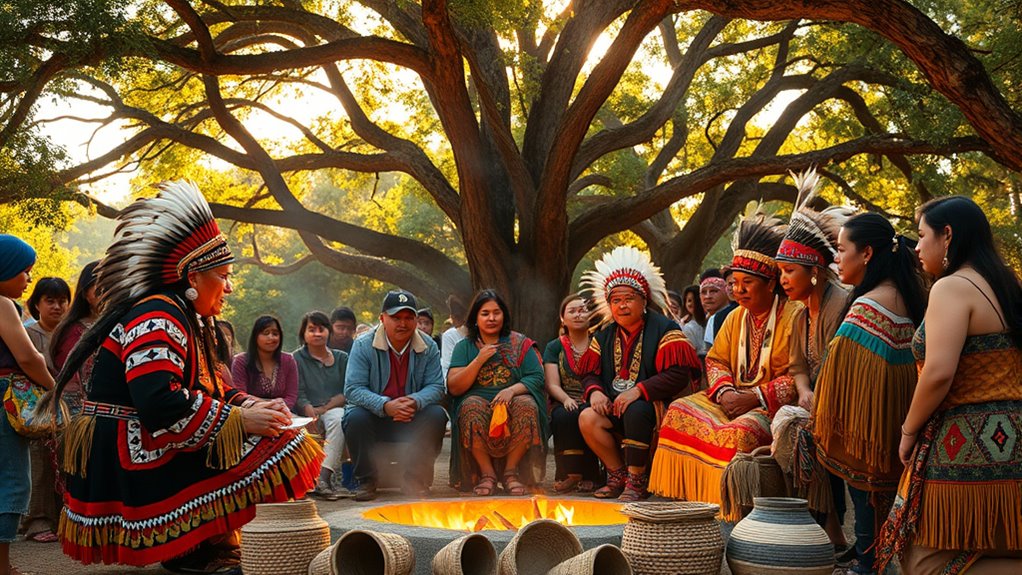
Have you ever considered how engaging with Indigenous stories and histories offers a deeper understanding of their cultures? When you listen to storytelling traditions, you connect with centuries of knowledge, values, and identity. Elders’ authority as keepers of stories ensures their accuracy and spiritual significance. To truly engage, keep these ideas in mind:
- Respect sacred stories and community protocols
- Listen attentively to Elders’ narratives
- Recognize storytelling as a means of cultural preservation
- Understand stories connect past, present, and future
- Support efforts to revitalize Indigenous languages through storytelling
Understanding storytelling styles can further enrich your appreciation of Indigenous cultural expressions.
Protecting Natural and Cultural Resources

Protecting natural and cultural resources in tribal tourism is essential to preserving the integrity of indigenous lands and traditions. Following eco tourism guidelines helps prevent habitat destruction, such as road widening that harms species like the coconut crab on Orchid Island. It also minimizes disturbance to protected species, avoiding disruptions to their propagation. Respecting sacred areas and traditional conservation practices reduces human interference and safeguards biodiversity. Proper waste management and noise control lessen environmental stress, while designated pathways and low-impact transportation protect fragile ecosystems. Community-based strategies, combining scientific methods with cultural values, ensure sustainable resource management. Indigenous leadership plays a vital role in regulating tourism impacts, balancing economic benefits with the need to uphold cultural preservation and protect sacred sites for future generations. Implementing sustainable transportation methods can further reduce environmental impacts, ensuring that tourism activities remain in harmony with nature.
Building Respectful Relationships With Community Members

Building respectful relationships with community members is essential for sustainable tribal tourism. It’s about fostering genuine connections through community engagement and respecting cultural protocols. By recognizing Indigenous authority and leadership, you guarantee decision-making power stays within the community, supporting cultural sovereignty. Establish formal agreements to clarify expectations and roles, avoiding exploitation. Engage community members actively in planning, including youth and elders, to ensure cultural accuracy and relevance. Maintain transparent communication channels to build trust and invite ongoing feedback. Use Indigenous language, stories, and oral histories to honor cultural identity. Prioritizing fair distribution of tourism benefits, including employment and local businesses, further supports community well-being. Incorporating Cultural Intelligence strategies helps ensure respectful and effective cross-cultural interactions, ultimately strengthening long-term, reciprocal partnerships rooted in mutual respect and respect for Indigenous knowledge and protocols.
Promoting Sustainable and Culturally Sensitive Tourism

Fostering respectful relationships with community members lays the foundation for tourism that is both sustainable and culturally sensitive. By supporting initiatives that prioritize cultural preservation, you help ensure Indigenous traditions, languages, and storytelling remain vibrant. Promoting ethical tourism encourages responsible behavior, respecting land rights and community well-being. When you engage in cultural exchange, you’re contributing to the preservation of authentic Indigenous experiences, which boosts local economies and empowers communities. Indigenous-led tourism models often integrate environmental conservation, aligning economic growth with ecological sustainability. Participating in cultural workshops and immersion activities fosters deeper understanding and appreciation of Indigenous heritage. Your respectful approach helps maintain the integrity of Indigenous cultures while supporting their social and economic resilience for generations to come. Incorporating Vetted tourism options ensures that your visit aligns with best practices for safety and cultural sensitivity.
Frequently Asked Questions
How Can I Ensure My Visit Respects Indigenous Sovereignty?
To make certain your visit respects indigenous sovereignty, focus on cultural sensitivity and respectful engagement. Follow community-specific guidelines, honor sacred sites, and listen to local protocols. Build genuine relationships rather than transactional interactions, and support Indigenous-led tourism initiatives. By doing so, you help protect cultural integrity, empower communities, and promote sustainable tourism that aligns with Indigenous self-determination and environmental stewardship. Your mindful approach fosters trust and long-term respect.
What Are the Best Ways to Support Indigenous Artisans?
To support Indigenous artisans, you should buy from local craft markets and seek authentic souvenirs that directly benefit the community. Avoid mass-produced imitations and instead choose products made by Indigenous artists, ensuring fair compensation. Share their stories and cultural significance with others to raise awareness. Supporting their efforts helps preserve traditions, boosts their economy, and promotes sustainable growth within Indigenous communities.
How Do I Handle Photography Requests Respectfully on Tribal Lands?
Handling photography requests on tribal lands is like walking through a sacred garden—you must tread carefully and respect the boundaries. Always prioritize cultural sensitivity and follow consent protocols. For example, I once asked permission before photographing a ceremony, and the community appreciated my respect. By communicating openly and respecting their wishes, you build trust and ensure your photography honors their traditions and privacy.
What Should I Do if I Encounter Sacred Sites Unintentionally?
When you unintentionally encounter sacred sites, prioritize cultural sensitivity and respectful communication. Immediately stop any ground disturbance and secure the area. Notify the appropriate authorities, like tribal representatives or cultural resource managers, and document the site without touching or removing anything. Follow legal protocols, respect Indigenous customs, and collaborate with community leaders to determine next steps. Your respectful response helps preserve these essential cultural sites and honors Indigenous sovereignty.
How Can I Learn About Indigenous Protocols Before Visiting?
Did you know that over 80% of Indigenous communities prefer visitors to understand their cultural etiquette before arriving? To learn about protocols, you should seek permission from local councils, send a formal letter of intent, and research community-specific customs. Respectful communication is key—use appropriate language, listen attentively, and follow guidance from community elders. This preparation shows your genuine respect and helps build trust during your visit.
Conclusion
By respecting protocols, supporting indigenous businesses, and engaging thoughtfully, you can create meaningful connections with tribal communities. Imagine visiting a pueblo and, instead of just sightseeing, participating in a traditional craft workshop that benefits local artisans. Your respectful approach helps preserve their culture and environment. Remember, responsible tourism isn’t just about seeing new places — it’s about honoring the people and traditions that make each community unique. Your mindful visit can make a lasting positive impact.
